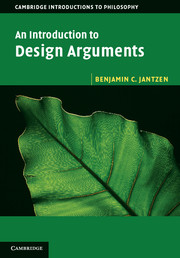Book contents
- Frontmatter
- Dedication
- Contents
- List of figures and tables
- Preface
- 1 Introduction
- 2 Preliminaries
- 3 Arguments from antiquity
- 4 Medieval arguments
- 5 The golden age of natural theology
- 6 Unusual design arguments
- 7 Hume
- 8 Paley
- 9 Darwin
- 10 Loose ends
- 11 The modern likelihood argument
- 12 Intelligent design I: irreducible complexity
- 13 Intelligent design II: specified complexity
- 14 What is complexity?
- 15 Supernatural agents and the role of laws
- 16 A brief survey of physical law
- 17 Fine tuning I: positive arguments
- 18 Fine tuning II: objections
- 19 Conclusion
- Bibliography
- Index
10 - Loose ends
Published online by Cambridge University Press: 05 June 2014
- Frontmatter
- Dedication
- Contents
- List of figures and tables
- Preface
- 1 Introduction
- 2 Preliminaries
- 3 Arguments from antiquity
- 4 Medieval arguments
- 5 The golden age of natural theology
- 6 Unusual design arguments
- 7 Hume
- 8 Paley
- 9 Darwin
- 10 Loose ends
- 11 The modern likelihood argument
- 12 Intelligent design I: irreducible complexity
- 13 Intelligent design II: specified complexity
- 14 What is complexity?
- 15 Supernatural agents and the role of laws
- 16 A brief survey of physical law
- 17 Fine tuning I: positive arguments
- 18 Fine tuning II: objections
- 19 Conclusion
- Bibliography
- Index
Summary
Overview
In our survey of the first twenty centuries or so of design arguments, we covered a lot of ground. In the process, many issues worth considering were raised but quickly set aside. This chapter collects a number of these issues together and gives each due consideration. The reader in a hurry can skip this motley collection without losing the thread of debate. But for those with nagging questions about the idea of purpose in nature, how much natural theology can establish about the attributes of God, or the connection between William Paley and Bernard Nieuwentyt, what follows will be of interest.
Purpose in nature
In Cicero’s dialogue De natura deorum, there appears an argument that rests on the observation of ‘purpose’ in the universe. This argument resurfaced centuries later in the great compendia of natural history such as Derham’s Physico-Theology. Despite the longevity of this sort of argument, we quickly passed over it with little scrutiny when it came up in our survey. It’s time we rectified that oversight.
- Type
- Chapter
- Information
- An Introduction to Design Arguments , pp. 153 - 169Publisher: Cambridge University PressPrint publication year: 2014

